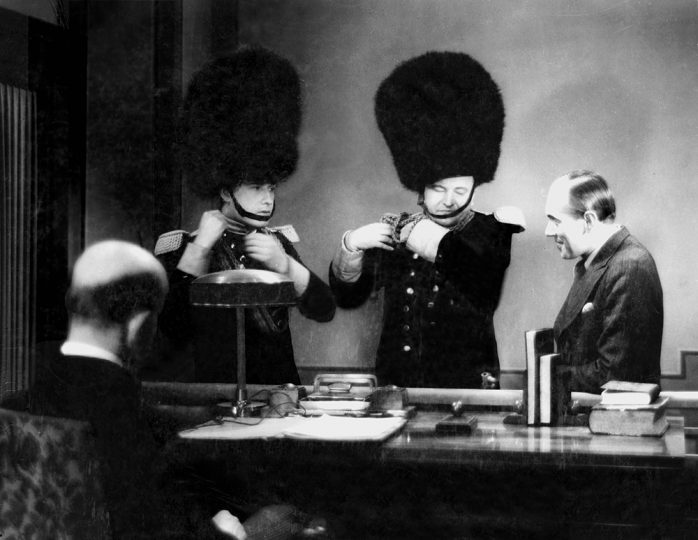„Your Money or Your Life is by far the best because there is no message, not much dialogue and we’re both great even though our timing is a bit off sometimes. But the main thing is it wasn’t made by Frič! My God, his hand was as light as a planet made of solid lead,“ wrote Jiří Voskovec in one of his letters to Jan Werich.[1] In the quoted passage, he recounts the films they made together. In the interwar period, their comedies revived and spiced up Czech film industry. Your Money or Your Life (Peníze nebo život, 1932) was the second of their four feature films. The first one was Powder and Gas (Pudr a benzin, 1931).
Voskovec and Werich, whose enchantment with the cinematograph and American culture was apparent already in their popular Vest Pocket Revue, actually appeared together on screen some time earlier. Their sketches were inserted between individual performances in the American musical revue Paramount on Parade (1930). For this occasion, they recorded a song titled Tři strážníci (Three Officers) with their theatre colleague Jaroslav Gradwohl. With their collaborators from the Liberated Theatre (Osvobozené divadlo), namely the pioneer of the First Republic theatre avant-garde, director Jindřích Honzl, graphic artist František Zelenka and composer Jaroslav Ježek, they filmed their first two films.
As the team had no previous filmmaking experience, they adapted the film language to the poetics of their „native“ medium. In their films, just like in theatre, they combined singing numbers with improvisation and humorous wordplay based on misunderstandings. They even kept the habit of breaking characters and commenting the plot. In case of Powder and Gas, the theatrical style was amplified by the setting – the film takes place partly during a new theatre performance rehearsal. On the other hand, the films, especially the first two, were less politically offensive than Voskovec and Werich’s satirical theatre plays.
Honzl realised that the plot of the first film was overly complicated. On top of that, Voskovec and Werich didn’t play lead roles so they couldn’t properly demonstrate their talents. That’s why the team decided to simplify the structure for the second film.[2] The film follows two former classmates who keep slipping each other stolen jewellery. The simplicity of the plot is, however, balanced by frequent elaborate humorous scenes and gags. In addition to American slapsticks, the inspiration came from early sound films by French director René Clair, referenced already in the prologue during the chase scene.
The films also included more compositions and songs by Jaroslav Ježek. He composed them during the script writing process so his work affected the film’s dramaturgy. The music, recorded by the Liberated Theatre Orchestra, plays a crucial role in exterior shots as they were filmed without contact sound as opposed to studio shots. Ježek’s music sets the mood, adds rhythm to the dialogue and contributes to the grotesque nature of the scene (for instance introducing family members with various instruments). The songs help to articulate the film’s main themes and define the characters. In addition to the titular hit song, the film introduces the popular blues song Život je jen náhoda (Life is but chance) sung in the film by Hana Vítová and Ljuba Hermanová.
Ježek’s music, more precisely the way it was integrated into the film, and Antonín Zelenka’s editing helped Voskovec and Werich’s second film to become more than a sequence of short theatre scenes. It’s dramatically more compact and thematically comprehensive. While wordplay and songs were the domain of the writers-actors duo and their high quality was anticipated, the sophistication of extensive silent passages was a surprise. They prove that Honzl managed to break out of the shackles of stage methods and was able to approximate his foreign inspirations. In addition to the aforementioned René Clair (particularly Le Million and À nous la liberté) and masters of silent slapstick like Chaplin, the film alludes to German expressionism – demonstrated for instance by its work with light and shadow in the museum scene.
Thanks to director Martin Frič, Voskovec and Werich’s following two films Heave Ho! (Hej-up, 1934) and The World Belongs to Us (Svět patří nám, 1937) were even more structured and closer to period concepts of modern conversational comedies. In these films, the legendary duo achieved harmony between the playfulness of slapstick comedy and their trademark engaging satire know from the Liberated Theatre. On the other hand, the biting political satire, more professional approach and adaptation to the conventions of film are probably the reasons why Voskovec retrospectively perceived Frič’s direction as heavy-handed and preferred Your Money or Your Life which was unique in the way it wasn’t formally refined.
No one managed to formulate the quality of the film better than Petr Král: „Rather than a clockmaker’s work of silent comedians, these comical bacchanalias remind more of pleasant holiday fun filmed with an amateur camera as a home video. It’s this „unprofessionalism“ that gives the film its unique charm and shows the poetry of the Liberated Theatre: they were able to goof off in front of the camera as if they were just having fun by themselves.“[3]
Your Money or Your Life (Peníze nebo život, Czechoslovaika 1932), director: Jindřich Honzl, script: Jiří Voskovec, Jan Werich, Jindřich Honzl, cinematography: Václav Vích, music: Jaroslav Ježek, cast: Jiří Voskovec, Jan Werich, Hana Vítová, Ljuba Hermanová, Eliška Pleyová, Theodor Pištěk, Theo Amady, Jaroslav Vojta, Jaroslav Hurt et al. Lloyd, 106 min.
Notes:
[1] Jiří Voskovec, Jan Werich, Korespondence III. Praha: Akropolis, 2010, p. 285.
[2] Poznámky režiséra Honzla k filmu V & W. Kino 2, 1932, no. 18 (3rd December), p. 4.
[3] Quoted in Vladimír Just, Před kamerou jen tak blbnout aneb Filmy V+W. Film a doba 56, 2011, no. 2–3, p. 76.


